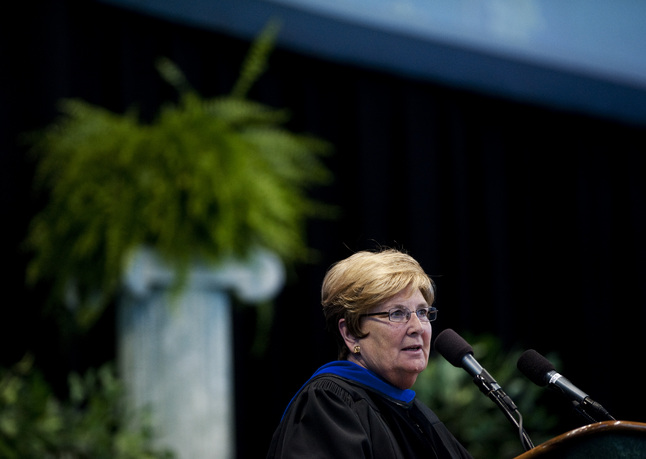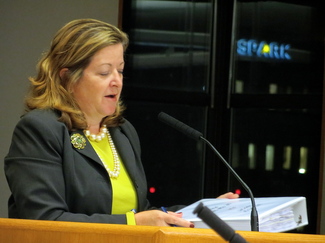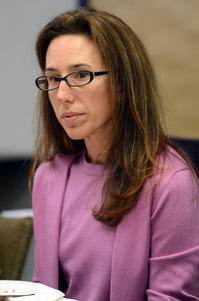
Ann Arbor schools Superintendent Patricia Green speaks during Skyline High School's commencement on Monday, June 10 at Eastern Michigan University.
Daniel Brenner I AnnArbor.com file photo
Ann Arbor Public Schools administrators knew the district was $1.3 million over budget in October, documents show — yet it was four months and another $1.2 million later before the Board of Education found out, and another month before a district-wide spending freeze was enacted.
When former Deputy Superintendent of Operations Robert Allen presented the district's first-quarter financial report on Nov. 7, 2012, both the report and a powerpoint presentation delivered to the school board showed the district was in line with its budget for the 2012-13 academic year.
Superintendent Patricia Green wrote in her memorandum to the board dated Nov. 2 that "the total budgeted revenues and expenditures remain unchanged for the first quarter."

Former Deputy Superintendent Robert Allen
By the time the school board was debriefed on the budget situation on Feb. 27 in the second-quarter financial report, the number of additional staff had grown from 11 to 29 and the current-year deficit was up from $1.3 million to $2.5 million.
AnnArbor.com obtained Allen's weekly capsule reports through a Freedom of Information Act request. Allen left the district in February to take a new job in North Carolina.
Every Wednesday, at Green's directive, executive cabinet members must submit a report to the superintendent of their division and the work they have completed.
Green then submits a compiled capsule report every Friday, with updates and additional information on her own tasks, to the Board of Education, summarizing the work of the district.
Ann Arbor Budget Crisis
Previous Coverage:
- Some 'clean up' needed on approved Ann Arbor Public Schools budget for fall
- By the numbers: 79 percent of Ann Arbor schools' cuts are staff reductions
- Letter: ACLU calls school board's decision to charge students for 7th hour 'misguided and illegal'
- Ann Arbor school board saves high school busing, reading intervention in harried budget decision
- WITH POLL: School board stipends: Fair compensation or a luxury of the past?
- Mum's the word: Ann Arbor principals union yet to negotiate new contract, pay cut
- Morning-only high school busing would save Ann Arbor schools $150K
- Ann Arbor school board still largely unwilling to budge on $5K food expenses
- Ann Arbor school district will have to pay unemployment insurance for laid-off teachers
- Budget crisis: Ann Arbor schools issues layoff notices for 233 teachers
- Surviving the budget cuts: Ann Arbor school board preserves $5,000 in food costs for meetings
- Ann Arbor PTO Thrift Shop may host targeted giving to save programs from budget cuts
- List: 80 employees, high school busing, middle school pools among $8.67M in proposed cuts
- Patricia Green's resignation letter to Ann Arbor board stresses zero-based budgeting
Capsule reports from October show the 11 teachers that were over budget were:
- Seven special education teachers, as the result of more special needs students enrolling;
- Four FTEs originally hired using Individuals With Disabilities Education Act grant money that had to be moved back into the general fund due to the grant money ending;
- And three teacher assistants hired to conform with the Americans with Disabilities Act.
The additional 8 FTE from October to February were due to classroom overages and teachers requesting part-time teacher assistants, Allen said in February.
About three weeks after the second-quarter financial report — nearly five months from when the district first saw signs of trouble — Green enacted a spending freeze. Her capsule reports to the board, which were obtained by AnnArbor.com, show the first week of the freeze was March 18.
A history of not updating
School board members were surprised, disappointed and beyond concerned in February when the second-quarter financial report was given, showing the $2.5 million deficit.
Trustee Andy Thomas said officials reported the district's enrollment was stable this year, "but then we somehow missed our budget in FTEs in the opposite direction and we don't learn about this until the end of February?
"To me this is unacceptable," he said at the Feb. 27 meeting. "This is one of the reasons we're in the financial pickle we're in. We need to do a better job of managing our expenses and managing our FTEs, and matching the number of FTEs with the number of students we have."
District spokeswoman Liz Margolis said in an interview Friday, Green did tell trustees about the initial budget shortfall in the fall of 2012 via her capsule reports to the board.
Vice President Christine Stead said Thursday in an interview, she was aware that a budget adjustment would need to be made second quarter because of some teacher FTEs. But a few of the staffing pieces and the exact extent of the problem trustees were not aware of until the February meeting, she said.
The first-quarter powerpoint presented by Allen on Nov. 7 showed 7 FTE, even though he had identified 11 in his report to Green.
Stead also explained it has long been the district's practice to not make budget adjustments after the first quarter. If officials see discrepancies in revenues or expenditures up or down from what they budgeted for, these typically are not reflected in the district's financial statements or corrected until the second quarter, she said.
Stead does not like this process at all, she said, and has voiced her frustration about this to administration numerous times. She especially feels it is necessary for the fund equity balance to be updated to what it actually is in every financial report.
"I hope we will change that practice because it is misleading," Stead said. "... If we know (expenditures and revenues will need to be adjusted), we should reflect them as we know them and how we know them, even if they change again later. ... I've said all along, I'd rather have surprises to the positive, than bad surprises. ... Especially since our capacity to address bad news — well, we just don't have it anymore."

AAPS Communications Director Liz Margolis
The district did make a $1.4 million budget adjustment during the second quarter, in which it transferred money from the district's fund equity, or primary savings account, to the general fund, Margolis said.
Improving practices
When asked about the district waiting until March to implement a spending freeze, Margolis said aside from wanting to wait it out, knowing the situation still could change between the first and second quarter, the delay also partially was due to experience the district has had with spending freezes in the past.
"They haven't resulted in the numbers, or been as effective as we've needed," she said.
But when the district did implement the freeze this year, she said officials did it in a different way than before, with "very strong controls." All purchases have had to go through Green for approval first. She personally has been authorizing or denying requests in order to help control spending and to curb unnecessary purchases.
Stead said, ideally, if you know you are going to be over budget in some areas, you want to put a degree of financial controls in place as soon as possible. But she added: "I could see how they might think they don't need to go to that level yet and might think maybe there'd be some additional revenue coming in to offset (the deficit)."
"But I would err on the side of putting in more controls and being more aggressive on spending freezes," she said.
Margolis said a spending freeze or a transfer to the general fund are really the primary means the district has for addressing mid-year budget deficits. Officials also try to reduce costs any place they can throughout the year, every year — deficit or not, she said.
The majority, about 87 percent, of the general fund is for personnel costs. So Margolis said other districts have issued mid-year reductions when they have been over budget, however, it has been Ann Arbor's practice and preference not to do that due to the disruption it causes for students.

Vice President Christine Stead
At the June 12 regular school board meeting, Stead requested that the board add into the 2013-14 budget $80,000 for a performance audit of the district's operations, specifically in the areas of finance, human resources and instruction, where AAPS seems to repeatedly have issues with the budget and staffing needs not aligning.
"Why I wanted this audit done is I'm hoping we'll get some guidance and recommendations on our processes around, not just financial controls, but how we manage our budget on a daily basis" ... including best practices for financial statements, Stead said.
"Ideally, we can and want to staff to demand, right? So I'd like to see us get some help on how we can help all of our buildings do a better job managing to a budget," she said.
The issue of equity
The budget bad news kept coming for AAPS well after the second quarter. In May, the district's third-quarter financial report revealed yet another $1.3 million had to be added to the current-year deficit, bringing the new total to $3.8 million.
The Ann Arbor Public Schools' fund balance has been depleted from $12.69 million to $6.87 million this fiscal year. In the 2013-14 academic year budget approved early June 13, the school board agreed to use another $1.18 million in fund equity to balance the budget.
Going into the next school year, AAPS will have $5.69 million in savings, just more than 3 percent of the district's $182 million in operating expenses. The recommended fund balance amount for AAPS is 15 percent of its annual operating budget.
Margolis said right now, district officials estimate that thanks to the spending freeze, $1 million will be added back into the district's fund balance at the end of the fiscal year, which is June 30. But, she stressed, because the fiscal year is not over yet, the district has not paid all of its bills.
It has yet to receive the final invoice from the Washtenaw Intermediate School District for transportation services; and in the third quarter, there were additional costs associated with substitute drivers that contributed to the district's $3.8 million current-year shortfall.
Danielle Arndt covers K-12 education for AnnArbor.com. Follow her on Twitter @DanielleArndt or email her at daniellearndt@annarbor.com.